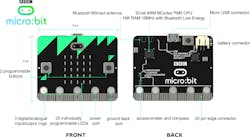One million “year sevens” (11- to 12-year old students) will be getting a tiny micro:bit (Fig. 1) to help teach STEM (see “Seven outstanding Micro Bit projects” on bbc.com). The tiny micro:bit module (Fig. 2) is built around a 32-bit ARM Cortex-M0 with 16 kB of RAM and Bluetooth Low Energy (BLE) support. It also has an accelerometer and compass chip on-board and an array of 25 LEDs plus a pair of buttons.
The module has no on-board battery, but there’s a power connector. The edge connector uses standard 0.05-in spacing. In addition, five large sections with holes could be used to mount a header, allowing a small stack to be created.
Applications can be built in a number of ways, including a graphical interface designed to simplify programming takes for new 11- and 12-year-old programmers. In theory, it should enable novice programmers to get started quickly. Providing some built-in devices like the accelerometers and compass should lead to applications that can actually do something. Also, the connectors make it possible to incorporate additional hardware. The theory is that a community, such as those associated with other platforms including Raspberry Pi and Arduino, will deliver supporting hardware and software.
In many ways, it’s a hardware approach to the code.org initiative that has garnered supporters like Bill Gates, Jeff Bezos. and Mark Zuckerberg. This and micro:bits look to expand adoption of computer science by the masses.
Can This Work?
The bigger question is whether this approach is a good idea. It’s essentially embedded programming and development, which we know isn’t really as easy as some would like you to believe. Keep in mind that students only have so much time to learn, so adding new things means something else has to give.
Don’t get me wrong. I raised three children who are all engineers, and they had some level of exposure to programming and computers; quite a bit actually. Only one did any major programming for science fair projects and she became a mechanical engineer. She was not too fond of programming, unlike her father.
Likewise, the science fair I help run, the Mercer Science and Engineering Fair, has few projects that utilize computers at this level. Some employed smartphones and required some programming, but that’s a far cry from a micro:bit.
On the other hand, the Intel International Science and Engineering Fair (ISEF) added multiple categories related to computer science. It’s led to increasing numbers of students involved with this type of research and engineering.
But back to the micro:bit.
The platform is cheap, small, and reasonable enough to do some very interesting projects. The challenge will be whether the teachers have been given enough support. Most will be unprepared to exploit or support work with an embedded system.
I haven’t been able to drill down into this aspect, but I hope that there’s already a critical mass of support material, training, etc. The micro:bit Create Code webpage lists two graphical (CK Javascript and the Microsoft Block Editor) and two text-based IDEs (Microsoft Touch Develop and Python). Unfortunately, many who want to push the technical aspects of a platform like micro:bit often overlook the importance and depth of support required to make such a platform successful in the long run. It does have major corporate support. However, that’s no guarantee the efforts will prove fruitful.
Nonetheless, let’s keep our fingers crossed for the platform and its deployment to succeed.


